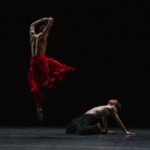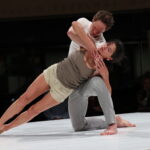In ballet class the final movement is always an elegant, choreographed bow or curtsy acknowledging the maestro, or accompanist.
Today, fewer and fewer classes offer live piano accompaniment, with teachers relying more on the iPod to provide the necessary musical inspiration. While traditionalists decry the encroachment of technology into the ballet studio, others have embraced the power that the iPod, together with iTunes, gives us – the vast range of music at our fingertips, and the ability to put our own, sometimes quirky, stamp on the class through the musical choices that we make.
Today, as you perform that révérence, bow your head in the direction of that sleek little sliver of stainless steel and say a silent Merci to Steve Jobs.
Maurice Béjart’s electrifying ballet Boléro, set to Ravel’s famous composition of the same name, may be a fitting tribute to Jobs – featuring a soloist dancing on an enormous round table, it calls to mind the iconic click wheel, the iPod’s brilliantly simple navigation component.
While Béjart cast his ballet variously with the lead danced either by a man or woman surrounded by a corps of men or women, Ballet to the People thinks the all-male version is the most powerful.
The original version of Boléro, choreographed by Nijinska, premiered at the Paris Opéra in 1928 and featured a Spanish gypsy dancing on a table. Béjart’s version, with its striking lighting effects, the scale of the table and the pounding repetitive movements, is at once minimalist and flamboyant, passionate to the point of being unsettling.
Is the dancer a prisoner being forced to perform against his will? Is he an unreachable object of desire? Is he a tyrant, whipping his subjects into a frenzy? He collapses at the end but his fall does not appear to reflect death or disintegration, but rather a final triumph.
R.I.P. Steve Jobs, and thank you for the music.






I’d love to see Bolero.
… also, my AAU class doesn’t offer a révérence at the end. 🙁 This is why I can’t wait to get back to your class!
The version on YouTube that I like the best is the clip included in my blog post above, with Paris Opéra’s Nicolas Le Riche dancing the lead – he does not quite have the fury or the passion of Jorge Donn (whom you can see in clips from Claude Lelouch’s film ‘Les Uns et Les Autres’) but Le Riche’s technique is beautiful, the quality of the filming is better in these more recent clips, and the male corps de ballet is outstanding.